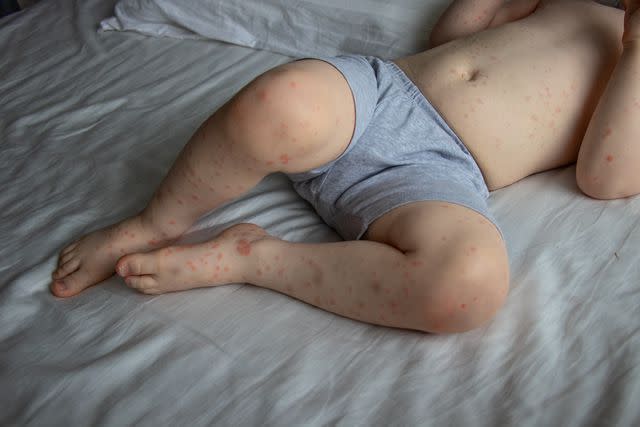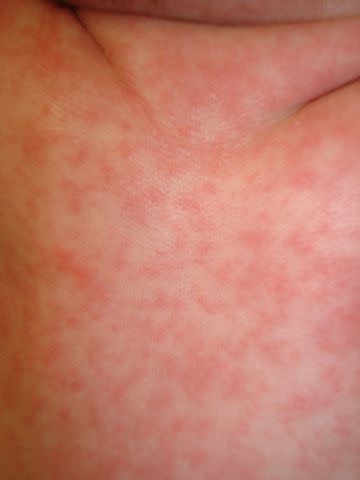Why Roseola Rash Happens After Fever
Medically reviewed by Casey Gallagher, MD
Roseola, also known as sixth disease or roseola infantum, is a viral illness that causes a high fever followed by a rash. The rash usually develops just as the fever resolves.
It is common in children ages 3 months to 4 years and most common in infants 6 to 12 months. Older children and adults can also get roseola, but it is rare. Most people with roseola do not require medical treatment. Home remedies usually include rest and fluids.
This article discusses roseola, its common symptoms, and when to call a healthcare provider.

Margarita-Young / Getty Images
Rash After Fever in Roseola
Roseola usually causes a high fever that lasts about three to five days. The fever can reach temperatures as high as 103 to 105 degrees. Just as the fever breaks, a rash usually forms on the trunk. The rash then spreads to the arms, legs, neck, and face. The rash usually appears as pink or red spots on light skin. On darker skin, the rash may be harder to see.

Reproduced with permission from © DermNet dermnetnz.org 2023
Learn More: A Guide to Viral Rashes in Adults and Children
What’s the Link?
Roseola is caused by the human herpesvirus (HHV) types 6 and 7. These viruses belong to the family of herpes simplex viruses (HSVs). Other types of HSVs cause cold sores or genital herpes.
Roseola is contagious and spreads through respiratory droplets. When a child with roseola talks, sneezes, or coughs, they send tiny droplets into the air. When other children breathe the same air or touch the same surfaces, they are exposed to roseola. Most children are most contagious during the fever phase of the illness.
Symptoms in Infants
Infants and young children are at the highest risk of experiencing roseola, typically ages 2 and under. Common symptoms of roseola in infants include a high fever followed by a rash, as well as:
Fussiness or irritability
Eye redness
Cough
Diarrhea
Vomiting
Learn More: What to Do if Your Child Has a Fever
Takeaway
Due to the high fevers, roseola raises the risk of febrile seizures. Rapidly rising body temperatures can trigger seizures. This happens in 10% to 15% of young children with high fevers. Symptoms of a febrile seizure include a period of unconsciousness, twitching of the arms and legs, jerking of the body, and a loss of bladder or bowel control.
Symptoms in Adults
Roseola is not common in adolescents or adults, but it is possible. Adults with roseola may experience several of the same symptoms infants do, including a high fever, rash, runny nose, cough, diarrhea, and vomiting. Adults may also notice a sore throat and swollen lymph nodes (lymphadenopathy) in the neck.
Home Treatment for Rash-Related Roseola
Most people with roseola can treat it safely at home. Medical care is usually unnecessary, and antibiotics are ineffective. Home remedies and care options for roseola include:
Over-the-counter (OTC) medications: If your child seems uncomfortable, consider giving them Tylenol (acetaminophen) or Advil (ibuprofen) for their fever. Never give an infant aspirin because it raises the risk of Reye’s syndrome (a rare disease that typically impacts the liver and brain).
Fluids: Give your child plenty of fluids to prevent dehydration. Depending on their age, options include breast milk, formula, water, soup, gelatin, and oral rehydration solutions like Pedialyte or Enfalyte.
Rest: Feeling tired is a common symptom of roseola; focus on resting as much as possible.
Learn More: Why Kids Shouldn't Take Aspirin
Takeaway
Call your child's healthcare provider if they have a high fever above 102 degrees. To help comfort them, provide plenty of opportunities for rest and hydration. Consider giving them over-the-counter medications if necessary.
Roseola Rash: Symptom Duration
A fever caused by roseola usually lasts between three and seven days. After the fever breaks, a rash develops for about 24 hours. When a child is exposed to roseola, they will usually develop symptoms seven to 14 days later. This is known as the incubation period (the time that elapses between exposure and when symptoms appear).
Returning to Day Care, School, or Work
Children with roseola are considered most contagious when they have a fever. After the fever breaks, they are much less contagious. Your child is safe to return to school or day care as soon as they have been fever-free for 24 hours. It is OK if they still have a rash.
When to Contact a Healthcare Provider
Roseola is a relatively common illness that usually does not need medical care. However, there are times when you or your child may require a healthcare provider's visit. Call your provider if you or your child experience:
A high fever that does not get better with OTC medications
Intense fatigue or lethargy
Seizures
Inability to eat or drink
Takeaway
There is no guaranteed way to prevent roseola. To lower your risk, practice regular handwashing and encourage handwashing with your children.
Summary
Roseola is a viral illness that usually causes a high fever followed by a rash. The rash often lasts about a day and is not itchy or painful. Roseola is most common in infants and young children. Although rare, older children, adolescents, and adults can also get roseola.
Common symptoms include a high fever, rash, runny nose, cough, sore throat, diarrhea, and vomiting. Most people with roseola do not require medical treatment. Home remedies usually include rest, fluids, and over-the-counter medications. Call your healthcare provider if you or your child experiences seizures.
Read the original article on Verywell Health.

